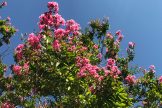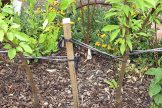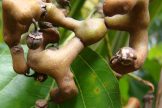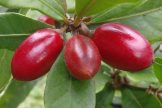
 Important note about plant availability. Important note about plant availability.There are hundreds of factsheets on our website provided for your information. Not all plants will be available at all times throughout the year. To confirm availability please call (03) 8850 3030 and ask for the nursery. |
The mango is widely grown across the world’s tropical regions and with a bit of care it is possible to have a slice of the mango pavlova right here in Melbourne and other southern areas. It becomes a large and dense shade tree of up to 40m in tropical areas but will reach a height between 3m (dwarf) and 15m when planted as a grafted specimen in Melbourne.
The mango is a self-pollinating tree, with the flowers forming on the end of branches, but may not set fruit if conditions are cold, wet and windy. The tree will require a frost-free position to become established as well as protection from strong winds.
Mangoes require a well-drained soil with a pH of 5.5-7, however they will do better in a sandy, poorer soil rather than rich over-fertilized soil. Fertilise in late winter/early spring and late spring/early summer with blood and bone until they reach flowering age. Then feed in summer as the fruit starts to form, as well as regular watering with seaweed solution.
When planting dig through plenty of well-rotted compost and aged cow manure and mulch well with pea straw, sugar cane mulch or Lucerne. Ensure that the mulch is kept away from the trunk of the tree to prevent rotting.
Prune trees to establish a single trunk 1-2m high then tip prune the leader. This will encourage multiple shoots for fruit production within reach.
Mangoes can fall prey to Anthracnose fungal disease. Symptoms of this may include black spots on flowers, fruit and leaves as well fruit failing to develop or prematurely falling. Ensuring that the tree is receiving a balance of nutrients will help prevent Anthracnose and soil testing to determine pH may help to ensure that all nutrients are available to the tree. Supplement the tree with potash in late winter to minimize occurrence of the disease. Pruning to increase air-circulation can help as well as the application of a low-impact copper based fungicide. Remove all fallen or damaged fruit, harvest ripe fruit daily and control fruit fly using pheromone baits.
The following varieties may be more tolerant of cooler climates
Nam doc mai
The Nam doc mai is a Thai type of mango with an elongated shape that may be eaten green or ripe and is often eaten as a pickled fruit. It tends to perform well as a regular cropper in cooler climates. It has yellow-green skin and is sweet, tender and juicy with an excellent flavour, is fibreless and low-acid. They are susceptible to Anthracnose so care needs to be taken to minimise the occurrence.
Kensington Pride grafted
A very common and popular Australian variety that has an excellent flavour, is very juicy and large in size. In cold areas it can be an irregular cropper, especially if wet. Medium risk of anthracnose.
R2E2 (Seedling)
The R2E2 is good sized fleshy mango with reliable cropping over a range of climates and a vigorous growth habit. The flesh is sweet and juicy and the skin is attractive with a lovely burnished colour.





